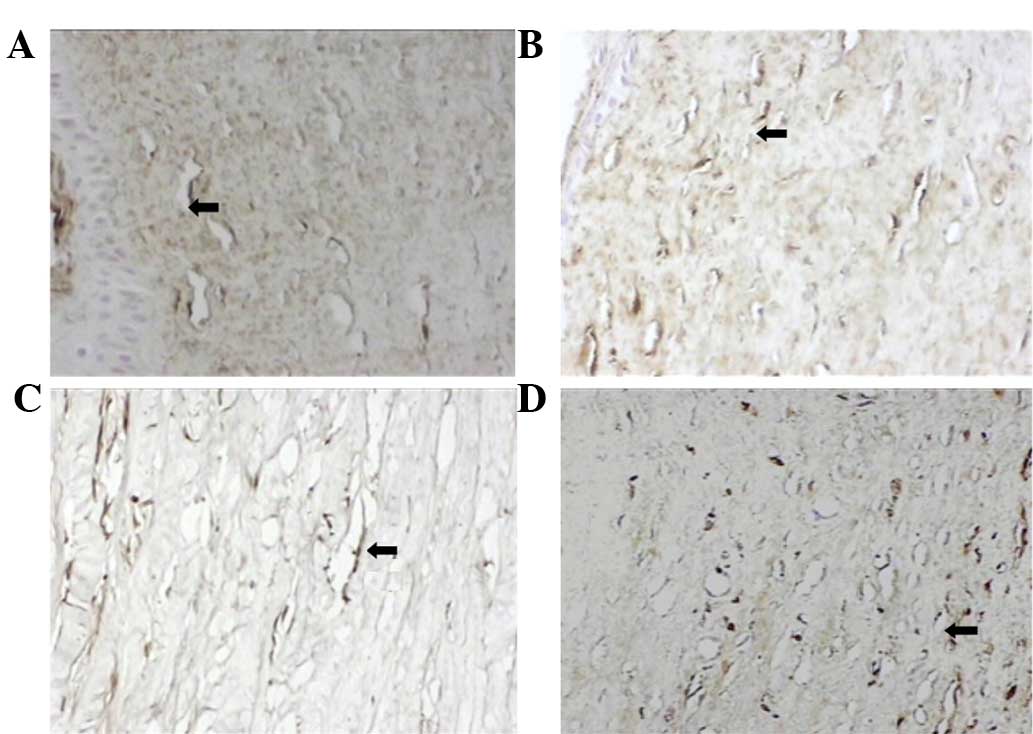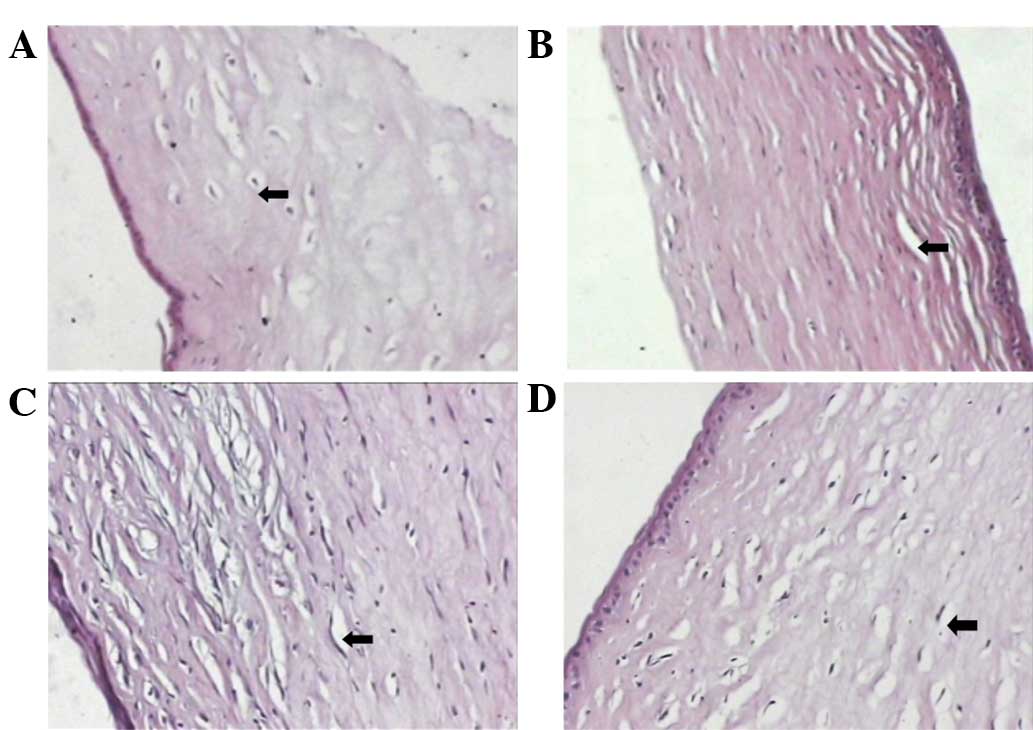|
1
|
O'Reilly MS, Boehm T, Shing Y, et al:
Endostatin: An endogenous inhibitor of angiogenesis and tumor
growth. Cell. 88:277–285. 1997. View Article : Google Scholar : PubMed/NCBI
|
|
2
|
Addison CL, Nör JE, Zhao H, et al: The
response of VEGF-stimulated endothelial cells to angiostatic
molecules is substrate-dependent. BMC Cell Biol. 6:382005.
View Article : Google Scholar : PubMed/NCBI
|
|
3
|
Dkhissi F, Lu H, Soria C, et al:
Endostatin exhibits a direct antitumor effect in addition to its
antiangiogenic activity in colon cancer cells. Hum Gene Ther.
14:997–1008. 2003. View Article : Google Scholar : PubMed/NCBI
|
|
4
|
Lai LJ, Xiao X and Wu JH: Inhibition of
corneal neovascularization with endostatin delivered by
adeno-associated viral (AAV) vector in a mouse corneal injury
model. J Biomed Sci. 14:313–322. 2007. View Article : Google Scholar : PubMed/NCBI
|
|
5
|
Mori K, Ando A, Gehlbach P, et al:
Inhibition of choroidal neovascularization by intravenous injection
of adenoviral vectors expressing secretable endostatin. Am J
Pathol. 159:313–320. 2001. View Article : Google Scholar : PubMed/NCBI
|
|
6
|
Yang L, Wang JW, Sun Y, et al: Randomized
phase II trial on escalated doses of rh-endostatin (YH-16) for
advanced non-small cell lung cancer. Zhonghua Zhong Liu Za Zhi.
28:138–141. 2006.(In Chinese). PubMed/NCBI
|
|
7
|
Zhuo W, Luo C, Wang X, et al: Endostatin
inhibits tumour lymphangiogenesis and lymphatic metastasis via cell
surface nucleolin on lymphangiogenic endothelial cells. J Pathol.
222:249–260. 2010. View Article : Google Scholar : PubMed/NCBI
|
|
8
|
Abdollahi A, Hlatky L and Huber PE:
Endostatin: The logic of antiangiogenic therapy. Drug Resist Updat.
8:59–74. 2005. View Article : Google Scholar : PubMed/NCBI
|
|
9
|
Liu Z, Ren Y, Pan L and Xu HM: In
vivo anti-tumor activity of polypeptide HM-3 modified by
different polyethylene glycols (PEG). Int J Mol Sci. 12:2650–2663.
2011. View Article : Google Scholar : PubMed/NCBI
|
|
10
|
Tan H, Yang S, Liu C, et al: Enhanced
anti-angiogenesis and anti-tumor activity of endostatin by chemical
modification with polyethylene glycol and low molecular weight
heparin. Biomed Pharmacother. 66:648–654. 2012. View Article : Google Scholar : PubMed/NCBI
|
|
11
|
Tan H, Yang S, Feng Y, et al:
Characterization and secondary structure analysis of endostatin
covalently modified by polyethylene glycol and low molecular weight
heparin. J Biochem. 144:207–213. 2008. View Article : Google Scholar : PubMed/NCBI
|
|
12
|
Ning TH, Chao CJ, Ying MG, et al:
Preparation, characterization and anti-angiogenesis activity of
endostatin covalently modified by polysulfated heparin. Pharmazie.
67:622–627. 2012.PubMed/NCBI
|
|
13
|
Bullock J, Chowdhury S, Severdia A, et al:
Comparison of results of various methods used to determine the
extent of modification of methoxy polyethylene glycol 5000-modified
bovine cupri-zinc superoxide dismutase. Anal Biochem. 254:254–262.
1997. View Article : Google Scholar : PubMed/NCBI
|
|
14
|
Han DW, Lee MH, Kim HH, et al:
Epigallocatechin-3-gallate regulates cell growth, cell cycle and
phosphorylated nuclear factor-κB in human dermal fibroblasts. Acta
Pharmacol Sin. 32:637–646. 2011. View Article : Google Scholar : PubMed/NCBI
|
|
15
|
Chen DQ, Wang X, Chen L, et al: Novel
liver-specific cholic acid-cytarabine conjugates with potent
antitumor activities: Synthesis and biological characterization.
Acta Pharmacol Sin. 32:664–672. 2011. View Article : Google Scholar : PubMed/NCBI
|
|
16
|
Pan X, Wang Y, Zhang M, et al: Effects of
endostatin-vascular endothelial growth inhibitor chimeric
recombinant adenoviruses on antiangiogenesis. World J
Gastroenterol. 10:1409–1414. 2004.PubMed/NCBI
|
|
17
|
Igarashi T, Miyake K, Masuda I, et al:
Adeno-associated vector (type 8)-mediated expression of soluble
Flt-1 efficiently inhibits neovascularization in a murine choroidal
neovascularization model. Hum Gene Ther. 21:631–637. 2010.
View Article : Google Scholar : PubMed/NCBI
|
|
18
|
Yoshida M and Tabata Y: Tumor targeting of
protein through poly (ethylene glycol) conjugation with metal
coordination. J Nanosci Nanotechnol. 10:877–885. 2010. View Article : Google Scholar : PubMed/NCBI
|
|
19
|
Peng LH, Shen W, Yong W, et al: Effects of
AMD3100 subconjunctival injection on alkali burn induced corneal
neovascularization in mice. Int J Ophthalmol. 4:44–48.
2011.PubMed/NCBI
|
|
20
|
Sun Y, Wang J, Liu Y, et al: Results of
phase III trial of rh-endostatin (YH-16) in advanced nonsmall cell
lung cancer (NSCLC) patients. J Clin Oncol. 23
(Suppl):71382005.
|
|
21
|
Folkman J: Antiangiogenesis in cancer
therapy - endostatin and its mechanisms of action. Exp Cell Res.
312:594–607. 2006. View Article : Google Scholar : PubMed/NCBI
|
|
22
|
Dosio F, Arpicco S, Brusa P, et al: Poly
(ethylene glycol)-human serum albumin-paclitaxel conjugates:
Preparation, characterization and pharmacokinetics. J Control
Release. 76:107–117. 2001. View Article : Google Scholar : PubMed/NCBI
|
|
23
|
Zhu B, Xu HM, Zhao L, et al: Site-specific
modification of anti-angiogenesis peptide HM-3 by polyethylene
glycol molecular weight of 20 kDa. J Biochem. 148:341–347. 2010.
View Article : Google Scholar : PubMed/NCBI
|
|
24
|
Norrby K: Low-molecular-weight heparins
and angiogenesis. APMIS. 114:79–102. 2006. View Article : Google Scholar : PubMed/NCBI
|


















